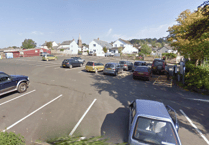CAMPAIGNERS opposing a plan to build a wind farm with nine turbines at Den Brook near North Tawton say they will fight the scheme ?tooth and nail?, following the formal submission of a planning application last week. Renewable Energy Systems (RES) have now submitted a planning application to West Devon Borough Council following a two-year programme to assess the site?s suitability for wind power generation. RES says the project will have a maximum capacity of 18MW, generating pollution-free electricity equivalent to the needs of more than 10,000 homes every year, or around half of West Devon?s domestic power consumption. The firm says the project would reduce emissions of carbon dioxide, the main greenhouse gas, by more than 37,000 tonnes a year, helping in the fight against climate change. Rachel Ruffle, project manager for the Den Brook proposal, said she was proud to propose this project to the people of West Devon. ?People can now look at the full details of the Den Brook wind farm, weigh up the pros and cons and make their views known to West Devon Borough Council,? she said. ?I have been encouraged by the level of support expressed when speaking to ordinary local residents about the project and I hope it won?t be long before wind power is bringing environmental and economic benefits to the area.? But Maureen Thomson, of the Den Brook Valley Action Group, said the 120m high turbines would be visible from a wide area: ?It is going to devastate the whole of this area for very little gain. ?It is totally out of scale with all the surrounding villages and rural landscape. The area is described by the CPRE as one of the last three remaining areas of tranquility in the whole of England.? Mrs Thomson said as well as visual impact on residents in Bow, Spreyton and North Tawton, opponents were also concerned about the noise the turbines would make when the blades were turning. ?It will affect not only people living here but also tourism, which is becoming the primary industry in the local economy. People will not want to come and see wind turbines in the countryside.? Mrs Thomson said she was pleased the uncertainty over the number of turbines had been settled as the developers had reduced the number of proposed turbines several times over the past year but had increased the height of the blades. The application is accompanied by a comprehensive environmental statement, including information on how the site was selected, the technical details of the project and the range of environmental studies undertaken. The non-technical statement submitted with the application states ?there would be significant visual effects upon an estimated 44 isolated residential properties.? The assessment made is that ?within and immediately around what is an isolated site, the turbines would be the dominant landscape features? but that beyond approximately 7km the turbines would ?only have a slight effect upon landscape character?. The document states each turbine would begin generating power automatically at a wind speed of around 3.0 m/s (6.75mph) and would shut down at a wind speed of around 25 m/s (56mph). The report also notes: ?The expected operational life of the wind farm is 25 years from the date of commissioning. At the end of this period a decision would be made as to whether to refurbish, remove, or replace the turbines. ?A wind farm can be easily and quickly dismantled and the site restored, leaving no visible trace of its existence, and no pollution for future generations.? RES says that as well as generating clean, green power, the project would bring positive economic benefits. Once generating, the wind farm would contribute at least £27,000 a year to a local community fund. RES says it will also be working alongside Dartmoor Railway to improve the railway line at North Tawton, to enable some construction materials to be brought to the site by rail.



